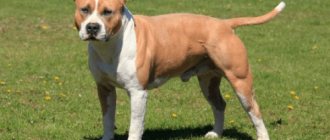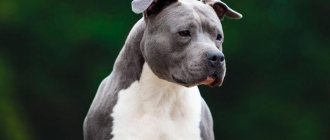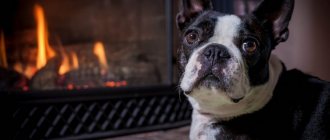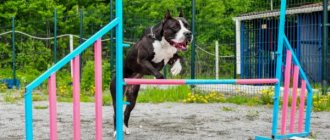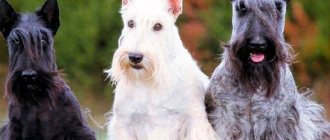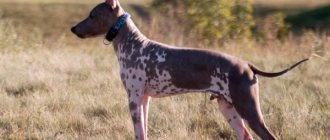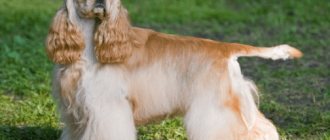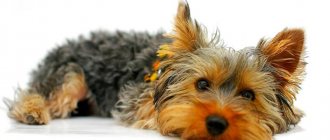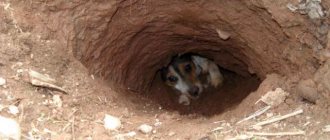The American Staffordshire Terrier is a versatile dog breed: staffs can work as guide dogs, rescuers or detectives. These are very energetic animals that require a lot of walks and movement. Active people should get an Amstaff to spend time with him traveling, fishing or playing sports. Modern Staffordshire Terriers are ideal for the role of a family dog: they are loyal, smart, brave and love children very much.
Amstaffs have very expressive facial expressions.
Main characteristics
| Breed parameters | |
| Country of origin: | USA |
| Weight of the breed: | males 25-30 kg, females 22-25 kg |
| Height at withers: | males 46-48 cm, females 43-46 cm |
| Temperament: | active |
| Wool: | short |
| Role in human life: | companion |
Many people consider the Staffordshire Terrier to be an angry, fighting dog, is this true? In fact, Amstaffs are companion dogs that get along well with other animals and love children very much, but in society it is generally accepted that this dog is a fighting dog. They are active, cheerful and unpretentious in maintenance. However, this is a very physically strong dog that requires its own approach and mandatory socialization from early childhood. Also, the owner needs to know how to properly train and raise this breed.
Dog health
The American Staffordshire Terrier is predisposed to the following diseases:
- skin diseases;
- problems with the digestive system;
- eye diseases;
- hip dysplasia;
- arthrosis.
To extend the life of a four-legged pet, it must be vaccinated annually. Mandatory procedures to maintain excellent health include quarterly worming and control of external parasites.
Photo: https://pixabay.com/photos/staffy-staffordshire-bull-terrier-1834207/
It is imperative to protect your dog during the season of increased activity of ixodid ticks - carriers of such a dangerous disease as piroplasmosis.
With proper care, representatives of the breed can live up to 15 years.
Origin story
The history of the origin of the Staffordshire Terrier breed goes back centuries. The first ancestors were bred around 1800, as evidenced by images in ancient engravings of England, Scotland, Ireland, Italy, Spain, as a result of crossing a bulldog and a fox terrier. In those days, they were used mainly for protection and as hunters; thanks to their power, they could easily knock down large game, in particular wild boars.
In 1870, representatives of this breed were first brought to the United States. Through selection from small European dogs, the Americans were able to breed an aggressive, courageous individual. They received a specimen that absorbed the aggression of a bulldog and the endurance of a fox terrier.
The question arises: why? The answer to it is banally simple - dog fighting. This is a betting that overnight covered all US states. People were ready to pay money for the spectacle that the staff showed them. The Staffords showed incredible stamina and endurance in battles; even when severely wounded, they continued the battle and fought to the last. Keeping an animal of this breed at home was considered stupid.
Years passed, times changed, and the Staffords underwent changes. They began to appear in private homes as guards and companion dogs. Uncontrollable aggression was replaced by friendliness and a cheerful disposition.
Learning ability
It is better to start training your staff as early as possible. These dogs are extremely smart and, with the right approach, are perfectly trainable in any type of canine sport - from agility to complex types of training. However, they can be stubborn - then the owner will need a fair amount of patience, consistency in behavior, as well as constant praise and proper reinforcement of the pet
Despite their brutal appearance, they are vulnerable creatures, so their training is much more successful if you work with them, avoiding rudeness and overly harsh influences. It is very important to socialize your puppy as early as possible. The Amstaff is very dependent on the mood and character of the owner, the dog adapts to him even in small things, so these dogs are not suitable for an unbalanced person.
This breed requires frequent physical activity, as well as constant mental work. They need to exhaust their energy by doing different interesting tasks. Otherwise, a bored staff member will chew the walls, gut the sofas and turn the yard into a lunar landscape with craters. Various fables about this breed are being circulated in the press, which have nothing in common with reality, and every well-trained staff can put an end to the absurd fictions and rehabilitate their breed.
Short description
The Staffordshire Terrier gives the impression of a large dog despite its very modest size. He is both elegant and strong, powerful, stocky, muscular, with a wide chest, a voluminous neck, and a wide skull. The ears are set high (usually cropped), the eyes are small - round and deep. The jaw is massive and strong. The staff's bite force, provided the bite is correct and has a full set of teeth, is approximately 22 atmospheres. Height and weight must be proportional.
The coat is short, shiny, without undercoat. Any coat color is allowed (except white) - solid, colored, spotted. The most popular: brindle, brown, dark red, blue (gray), black.
Care and maintenance of staff
The appearance of a Staffordshire Terrier puppy in your home will not go unnoticed. As soon as the staff appears in the apartment, they will immediately begin a thorough inspection of the territory and check every corner. It is important to immediately designate his place to sleep, otherwise he will not miss the opportunity to settle in the center of your bed.
The safest and most comfortable sleeping option for a small staff is a cage. It is necessary and desirable to train him to just sit quietly in it, like any other pet, regardless of breed. The cage will become a safe haven for the pet, especially during the absence of the owner. Being in a confined space, a puppy or an adult will not be able to harm itself by eating something inedible and will not destroy the house. As you grow older, you will no longer need to constantly use the cage.
There are no special problems in caring for the coat. Usually a simple brush with stiff bristles is enough to keep the coat looking well-groomed, shiny and healthy. Frequent bathing can damage the coat and its structure. Nails need to be trimmed as the nail grows. This procedure is recommended to be performed by the family member to whom the dog obeys unquestioningly.
Caring for the health of your staff includes annual vaccination in accordance with veterinary recommendations, as well as mandatory preventive measures and hygiene procedures. It is very important to pay close attention to the staff’s oral cavity.
How to choose a puppy
Let’s make a reservation right away: if you want to buy a purebred Amstaff, then the options of the bird market or advertisements on the Internet are immediately and unconditionally dismissed.
The procedure for purchasing from a specialized nursery has been well established for a long time, and you should definitely be familiarized with it in detail, if, of course, we are talking about a place with a good reputation. In this case, it is important to know that when buying a dog it is better to enter into a formal contract. Sometimes the form of purchasing a puppy “under contract” offered to clients has a number of nuances that can infringe on the owner’s rights to both the dog itself and its future offspring.
The third option is to buy an American Staffordshire Terrier puppy yourself from an experienced and trusted breeder. In this case, experts recommend paying attention to the following points.
American Staffordshire Terrier puppy face
- When planning a show career for your dog, ask the owner of the bitch to give you the opportunity to observe the development of the babies. The Amstaff's future traits are best demonstrated at birth, on the third day of life and at the age of one month. It is unlikely that you will have time to see the baby on the first and third days, but the monthly period is worth studying more closely. It is at the age of thirty days that the small American Staffordshire Terrier is an exact miniature copy of what can grow out of it, subject to all the rules and conditions for raising dogs of this breed. Don’t take stories that the deficiencies visible at this age can be corrected with a massage, a special diet, or some kind of “dancing with tambourines.”
- American Staffordshire Terrier puppies, which have a lot of white in their color, may not have completely colored noses, eyelids and lips, but partial coloring should definitely be observed. This process is finally completed by 8 months of age (sometimes a little later). The color of the iris of the eyes acquires its final shade even later, so you need to be very attentive to the eyes of a soft blue color, especially if the puppy has a fawn-blue or red-blue coat color.
- The puppy's coat should be short, “velor”, without bald spots. Skin without ulcers and pustules.
- The ears should be clean, without any unpleasant odor. The eyes are clear, without signs of souring. Under the tail it is clean and dry.
- If you notice a small hernia during examination of your abdomen, do not be upset. This problem can be dealt with through simple procedures.
- A Staffordshire Terrier puppy at this age should weigh from 2.5 to 5 kg, look fairly well-fed, without protruding ribs or rumps. In addition to mother’s milk itself, the baby’s diet should already contain other dishes: kefir, cereal porridge, scraped meat, cottage cheese.
An interesting fact is that the bitch sometimes regurgitates recently eaten food to her puppies, and the kids happily pounce on such a treat. This is absolutely normal and is explained by natural instincts. Moreover, this behavior indicates a well-developed maternal instinct, which is highly likely to be inherited by all female puppies in this litter.
You are unlikely to buy the baby you like right away. The sale of an Amstaff is permitted after it reaches the age of 45 days and the owner of the bitch has completed the mandatory branding procedures and expert assessment. Your first visit to the nursery will be more of an informational nature, but it will not be superfluous to thoroughly prepare for it by collecting the maximum amount of information.
Activity level and walking of the staff
How much exercise does a Staffordshire Terrier need? The answer to this question is purely individual and depends on the character, as well as the needs of a particular animal. The Staff Terrier is an energetic dog, so it needs to be walked at least twice a day. Walking should take place in open areas so that the dog can run, jump and be free. Puppies need to be walked more often.
If you leave your Stafford unattended for the whole day in the yard of your house, then you should forget about the pet’s ideal physical shape. For an Amstaff, such walking will be equivalent to being kept in an enclosure. Having chosen this breed for yourself, review your schedule and find time for walks with your pet. Even a simple walk around the block will bring results and partially satisfy your pet’s daily needs.
Dog training for Staffordshire
As we have already found out, every Staffordshire Terrier must undergo a general training course. The intelligence of these dogs allows them to easily remember all the basic commands and their combinations, and their high nervous activity allows them to fulfill the owner’s requirements clearly and quickly. That is why you should not limit the staff to only initial training: depending on the characteristics of a particular dog and the desires of the owner, you can go further, choosing one or two more complex canine disciplines for improvement. Below we will tell you in what areas you can develop the talents and breed characteristics of Staffordshire Terriers.
Staffs successfully perform in many cynological competitions and sports.
Agility
A dog sport ideal for fast, agile and lean Staffordshire dogs. The essence of agility is for the dog to go through an obstacle course consisting of several projectiles as quickly as possible. In the classic version of agility, the dog must overcome a slide, several barriers of different heights and types, tunnels (hard and soft in which you need to crawl), boom, swings, slalom (vertical sticks that the animal passes like a “snake”). Agility is an incredibly exciting and fast sport, and it is of particular interest because the animal cannot be forced to go the distance. According to the rules, the dog enters the playground without equipment, that is, a collar and leash, and the owner has the right to control the pet only with his voice, encouraging and directing the tailed athlete.
Staff passes the “Swing” projectile
How are agility competitions held? Where in Russia can you learn agility and how to start training? More details in a special article.
Waitpulling
A power dog sport in which the muscular and hardy Staffordshire Terriers occupy a leading position. Its essence is that a harness is put on the animal, which is attached by a cable to a cart on which there is a load, and the dog must move it a certain distance in a minimum time. As in agility, the owner cannot force the animal to pull a load; it is prohibited to influence the dog physically, by threatening or shouting.
Of course, a certain weight of cargo is provided for the weight of each dog, and animals, in order to be allowed to compete, must have veterinary certificates of complete health. It should be noted that weightpulling promotes the physical development of Staffordshire, since training begins with minimal weights, gradually increasing the load.
Weightpulling training
Protective guard service
Protective guard service or ZKS is the most suitable discipline for Staffordshire dogs as bodyguard and security dogs. This type of training aims to develop the animal’s skills in guarding and protecting (not only itself, but also the owner or his property), as well as teach the dog to use its main tool - its sense of smell. A dog that has completed the ZKS course will be able to detain and escort a person, protect the territory and things entrusted to it, and also choose from a number of objects its own or someone else’s. Note that you need to start studying the ZKS after the Staffordshire Terrier has completed the OKD or UGS courses. This is necessary so that the animal behaves in a disciplined manner and skillfully concentrates attention on its owner and his commands.
The dog’s opponent at the ZKS is a person wearing a protective suit.
Mondioring
A protective art that combines both obedience and security tests for dogs. This is a complex, rhythmic and spectacular sport, during which the animal must instantly switch from carrying out various commands to escorting and attacking the person involved, as well as overcoming obstacles (barriers of varying complexity in combination with fetching - presenting objects).
Mondioring is a stressful test for a dog, since in the process of following commands and solving problems, the animal is influenced in various ways: smoke can be blown around the dog, it is distracted by toys, food, other dogs or noisy sounds. During the competition, the animal must show the highest level of execution of basic commands, perform high and long jumps, and also solve problems of attack, defense, guarding, searching for a person and escorting.
Defendant's attack
Frisbee
An outdoor game with a flying disc, based on the interaction between dog and owner. The person’s task is to make a series of spectacular throws, the dog’s task is to guess the Frisbee’s flight path and catch the disc before it touches the ground, and then bring it to the owner. During frisbee training, the dog is taught not only to catch and retrieve an object, but also to make the correct jumps and land technically.
Participation in frisbee competitions allows the Staffordshire Terrier not only to burn off energy and get the necessary level of physical activity, but also to strengthen the relationship with the owner. This is a pairs sport in which success depends on the well-coordinated partnership work of a person and his pet. In addition, Staffordshire Terriers are agile and agile dogs, for whom chasing a flying disc brings incredible pleasure.
Stafford learns to catch a frisbee
Canicross
A type of sled sport in which a person and a dog must overcome a certain distance for a while. The dog goes to the start wearing a special harness, from which a cable cord extends, connecting the pet to the owner. A person has a cable attached to his belt, leaving his hands free for better running technique. Participation in canicross competitions involves regular training, in which the load and distance that participants must cover gradually increase. Canicross combines obedience and physical activity, as the dog must not just run with a person, but interact with him. So, on steep climbs the animal helps the runner, pulling him along with him; on descents, on the contrary, the pet must slow down so as not to drop the person. In addition, the dog must know the commands “Right!” and “Left!”, and also calmly treats other participants in the distance, without trying to interact with them.
Jogging with the owner gives the staff a lot of positive emotions
Basic rules for raising staff:
- Walks. It is advisable to walk often and for a long time. You cannot walk your dog on a leash. Staff needs freedom and the opportunity to use their full muscle potential. The habit of walking nearby without a leash should be cultivated in the staff from early childhood. A dog of this breed that experiences a constant lack of freedom will be less amenable to training. Proper walks are the basis of a normal relationship between the owner and the Staffordshire Terrier, as well as its psychological state.
- Good socialization among other individuals. The ability to communicate and a ban on aggressive behavior is an example of proper upbringing. The dog must learn to communicate with brothers of different sizes, ages, and temperaments. Under no circumstances should even the slightest manifestation of aggression towards other animals be ignored. The pet must understand that fighting is prohibited under any circumstances. To control the behavior of the staff, you can use special toys: tourniquets, balls, rags.
- Obedience. Obedience is the main point of effective dog training. Obedience education and training can be different, but according to modern methods it is conflict-free. Experienced instructors recommend a dosed conflict between the dog’s desires and the person’s demands on it on a regular basis. As a result, the staff becomes more stress-resistant and obedient.
All of the above recommendations should be applied in combination, then they will complement each other and work. If you don’t take care of the staff and don’t let him off the leash, you are guaranteed to have problems.
Character of the American Staffordshire Terrier
If we talk about the character of the Amstaff, then there is hardly another breed of dog whose character would be described by such diverse, and sometimes completely opposite, epithets.
Amstaff with owner
Reliable, intelligent, loyal, endowed with a considerable amount of fun and even some playfulness, balanced and self-possessed - this is what lovers of the breed say about the Staffordshire. Aggressive and vicious - this is the assessment given by critics of the breed. But the latter character traits are associated in almost all cases with either inept or with education aimed at the formation of negative qualities.
Anyone who wants to have such an animal should firmly understand that the American Staffordshire Terrier is a very powerful dog with pronounced guard and fighting qualities. She will until the end protect not only the members of the family in which she lives, but also the integrity of the territory entrusted to her from any encroachment. With such inclinations, a properly raised Amstaff will show aggression only if it feels threatened from the outside. A dog's intuition is so strong that sometimes it seems that it reads the thoughts of your ill-wisher. The Staffordshire Terrier attacks very often without “declaring war.” Barking and growling are for weaklings. The dog fights until complete victory; it is almost impossible to stop him. In “peak” situations this is quite acceptable, but in everyday life such behavior can cause many problems, so proper education and skillful socialization of the dog are very important. By letting your puppy know that all members of your family are his friends, you will eventually get a loving, attentive and devoted friend.
Initially, one of the goals in developing the Staffordshire Terrier breed was to obtain a dog that was best suited to perform the function of family protector. People of all ages can easily find a common language with Amstaff. For children, the dog will become a gentle, attentive nanny who will patiently endure all the little ones’ pranks. But you still shouldn’t leave your dog alone with very young children.
In a calm home environment, the American Staffordshire Terrier can be the sweetest creature, trying in every possible way to amuse and please its owner. But the authority of the latter must be indisputable, and only a fairly experienced owner can cope with such a strong spirit and body dog. In order to control the Amstaff and manage his natural instincts, desire alone is not enough - you cannot do this without professional knowledge and skills.
American Staffordshire Terrier with cat
Amstaff walks with a child
Nutrition
To maintain proper physical condition, Staffords must eat well and properly. A massive and strong bone requires a high calcium content, so you should take care of special dietary supplements and vitamin-mineral complexes in advance. The digestive system of Staff Terriers is not particularly complex; its focus is on quickly digesting the food consumed. It is not recommended to feed an adult high-calorie food.
Many pets happily eat food from their owner's table. You should not get carried away with such experiments. Unbalanced food can lead to serious health problems for the staff. It is better to give preference to a natural diet, with a predominance of meat and meat and bone products.
List of natural products:
- meat (beef, lean pork, poultry)
- bones
- offal
- dairy products
- eggs (boiled)
- porridge
You can feed your pet special super premium dry diets. As a treat, you can give beef sugar bones to chew on.
Safety regulations
So, you have a Stafford. The dog, the photo of which is presented below, is a fighting breed, so you should follow special rules of conduct with it in public places:
If you live within the city, wear a leash and muzzle on your pet when walking.
Do you live in a country house? Never leave your dog outside unattended. The animal must be in a yard or a special enclosure.
But situations still occur when an animal gets involved in a fight. In this case, a quick reaction from the owners is important:
You should never get between dogs. In the heat of a fight, they may attack you.
It is imperative to remove the animals, but hitting them is strictly prohibited. Increased aggression can lead to negative consequences.
Two people must separate the animals. Everyone will be responsible for their pet. Look carefully at which animal grabbed your opponent. Take a stick and gently open his jaws.
After the dogs have been separated, they need to be taken in different directions. After a fight, you should not immediately allow the animal near children; wait until the attack of aggression has completely passed.
Dog fights happen quite often, remember these simple rules, and you will always be in control of the situation.
Diseases
In general, Amstaffs are healthy and rarely vomit. With proper nutrition, a sufficient level of physical activity and proper care, owners, as a rule, do not have problems. However, like most purebred dogs, Staffordshire dogs have a number of diseases that are much more common than others.
The most common diseases of the Staff Terrier:
- skin allergies;
- UTI;
- autoimmune diseases;
- osteoarthritis;
- dysplasia of the hip and elbow joints;
- hypothyroidism;
- cerebellar ataxia (hereditary disease);
- demodicosis;
- diseases of the cardiovascular system.
We study Stafford in detail
The Stafford dog looks great in appearance. Thanks to his fighting qualities he has:
long strong legs;
short hair;
strong, strong muscles that stand out when running or other physical activities.
Many people are interested in: “What does a Stafford dog look like?” The answer is obvious: powerful, smart, beautiful. The height of the dog is on average 45 cm, while the weight is quite large - up to 30 kg. The color is either solid or spotted.
The dog has enormous physical capabilities and sporting potential. It needs to be actively developed. For these breeds there is a special set of exercises in the gym.
